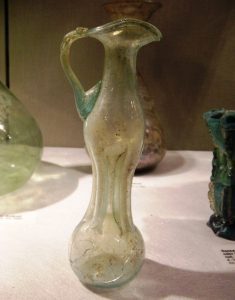Guttrolfe - German/German

Probably one of the most unusual and enigmatic forms for glass vessels is the guttrolf. The name, derived from the Latin "gutta", the drop, and "guttura", the throat, explains the purpose of the vessel: to let a liquid run down the throat drop by drop.
The Glass Museum's Guttrolfe are the heart of the collection. They formed the beginning of the museum founder Dr. Hans Löber's collecting activities in the 1940s. The foundation of the glass museum in 1976 can be traced back to a five-tube Roman jug from the 3rd or 4th century. For a long time, the glass physicist had no peace about its manufacturing technique. Thus, the search for a solution resulted in what is probably the most remarkable Guttrolf collection in Germany, with over 30 examples from various countries from the 5th to the 19th century.
With the master glass apparatus blower Leonhard Macholdt from Wertheim, Löber revived the old glass techniques that had fallen into oblivion. This included blowing a multi-tubular guttrolf on the blowing lamp. The decisive factor for solving this technical problem was a document about the glassworks in the Spessart region from 1405, which describes a daily production of 300 small cups and 200 Guttrolfs. To produce this large number of pieces was not possible by the previously assumed complex fusing or assembling technique of individually manufactured tubes. There had to be a simpler way of handling them: In this process, a round tube is swaged into a square. By sucking instead of blowing, the walls collapse in such a way that a total of five tubes are created. By reheating, a twist in the form is possible, so that one believes five tubes have been created at the neck.
Guttrolf - English

One of the most exceptional and puzzling glass container shapes is known in German as a Guttrolf. The name is derived from the Latin "gutta", meaning drop and "guttura", meaning the larynx, which explains what it was used for: to allow liquid to flow drop by drop into the larynx.
The Guttrolfs in the museum of glass are the centrepiece of the collection. During the 1940s they are what inspired the museum founder Dr. Hans Löber to begin collecting glass. The foundation of the museum in 1976 goes back to a five-cylinder Roman jug dating from the third or fourth century. The glass physicist just couldn't work out how it had been made and during his search for a solution he collected the most comprehensive Guttrolf collection in Germany, comprising over 30 examples from various different countries dating from the fifth to the 19th century.
In collaboration with the master glassblower for glass apparatus, Leonhard Macholdt from Wertheim, Löber revived the old forgotten glass production techniques. The ability to blow a several cylinder Guttrolf using a blowtorch was one of them and a document about the glass foundries in Spessart dating from 1405 was decisive in finding a solution to the technical problem. It describes a daily production of 300 small beakers and 200 guttrolfs, which went against the complex smelting and mounting technique of the separate cylinders that had been supposed up until that point. So, there must have been a simpler way. A round cylinder can be squeezed together into a square shape, and the air is sucked out instead of being blown in, which makes the walls of the glass fall together, so that altogether five cylinders are created. During reheating the shape of the glass can be contorted so that it looks as if five cylinders were created in neck.